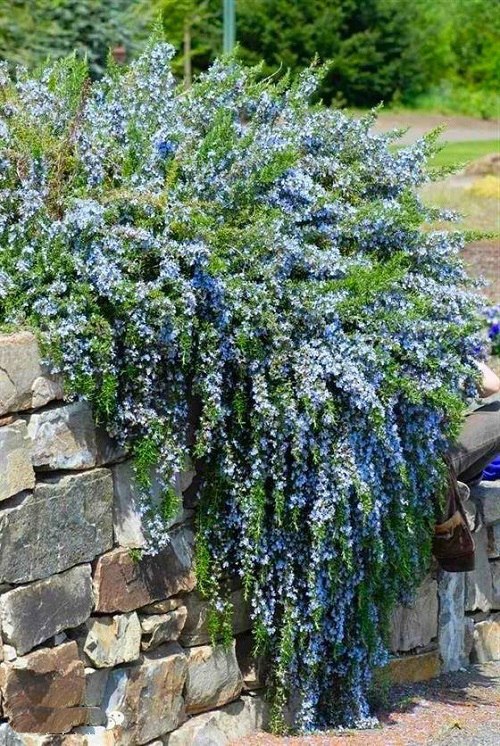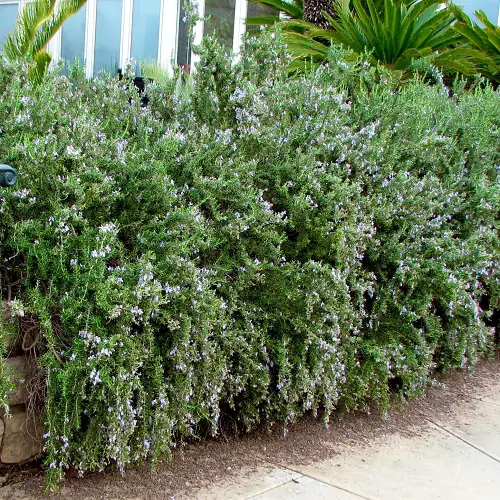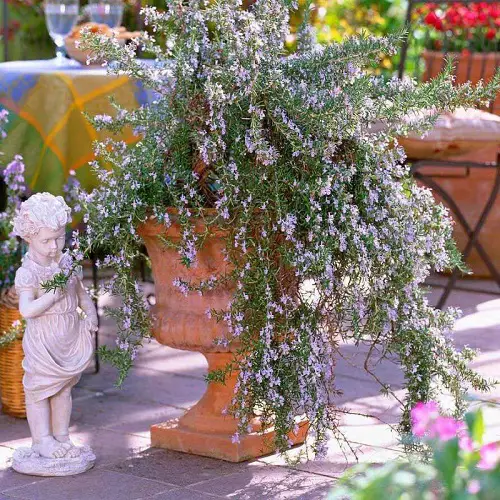Here are some of the best Creeping Rosemary Varieties, perfect for adding beauty and fragrance to any garden or landscape!
Whether you want to fill gaps in the rock garden or make your dish more flavorful, these creeping rosemary varieties are the perfect option. Let’s find out about these specimens in detail below.
Best Creeping Rosemary Varieties
Creeping rosemary thrives in full sun. It requires at least 6 to 8 hours of direct sunlight each day. Choose a location that receives ample sunlight throughout the day, preferably with minimal shade or obstructions.
1. Capri
Botanical Name: Rosmarinus officinalis ‘Capri’
With 15cm height and a meter width, ‘Capri’ is the perfect low-spreading rosemary variety for a groundcover. It beautifies landscapes with needle-shaped foliage and tiny blue blossoms in spring.
2. McConnell’s Blue
Botanical Name: Rosmarinus officinalis ‘McConnell’s Blue’
‘McConnell’s Blue’ is a prostrate shrub with plenty of two-lipped blue blooms and dark green aromatic leaves on creeping stems. It needs a moist, well-drained potting medium and full sun to grow in pots or on the ground.
3. Santa Barbara
Botanical Name: Rosmarinus officinalis ‘Santa Barbara’
This rosemary variety is a vigorous, evergreen ground cover that draws bees and other beneficial insects. Besides a ground cover, ‘Santa Barbara’ is used in ornamental gardens and kitchens to flavor dishes.
4. Lockwood de Forest
Botanical Name: Rosmarinus officinalis ‘Lockwood de Forest’
‘Lockwood de Forest’ can create a beautiful 6-8 feet wide carpet of aromatic, bright green foliage and lavender-blue flowers. This creeper was first found in the Santa Barbara garden of Lockwood and Elizabeth de Forest, hence the name.
5. Huntington Carpet
Botanical Name: Rosmarinus officinalis ‘Huntington Carpet’
Make your garden stand out with the needle-like leaves and blue blooms of this attractive ground cover. It’s a great option for retaining walls, raised beds, rock gardens, and container gardening.
6. Prostratus
Botanical Name: Rosmarinus officinalis ‘Prostratus’
Native to the Mediterranean region, Prostratus is a low-growing, highly aromatic shrub that offers clusters of bluish flowers in spring and summer. Bees, butterflies, and hummingbirds visit this plant often.
7. Irene
Botanical Name: Rosmarinus officinalis ‘Irene’
‘Irene,’ also known as ‘Renzel,’ is a prostrate rosemary cultivar that can become 12-18″ tall and 24-36″ wide in optimal growing conditions. You can drape this plant over rock walls to enhance your landscape’s overall appearance.
8. Blue Lagoon Rosemary
Botanical Name: Rosmarinus officinalis ‘Blue Lagoon’
Blue Lagoon produces deep blue flowers that complement its needle-like dark green leaves. Apart from its ornamental usage, this herb is a popular addition to culinary dishes.
Fact – Besides enhancing the look and feel of your garden, rosemary has some science-backed benefits, too.










